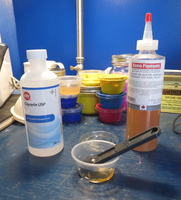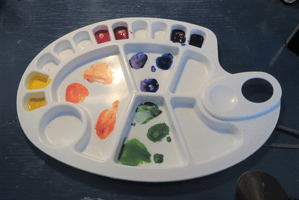At my school we use tempera blocks a lot.
| Pros | Cons |
|---|---|
| Cheap as heck | Cheap high-filler pigments |
| Good enough for beginners | Non-primary colours |
| Easy to stick to paper palettes | Crappy, slow wetting binder |
| Students bore a hole down the middle | |
| Students tempted to mix without a palette |
I have been doing experiments to see if we can recycle the paint once students have bored a hole in the middle of each one, and reuse the pigment.
Here is how I recover pigment from used tempera pucks:
Equipment
- Used tempera blocks
- A couple of jugs, buckets, or other containers.
- A fine mesh strainer.
- Hot water
- Wooden spoon for stirring
- Containers for storing recovered pigment
- Clove oil or other anti-fungal agent
Procedure
-
Melt down the pucks.
This takes time. Break down the pucks if you can, but don't overdo it. Don't bother washing them: it will not make a noticable difference. Throw them into a bucket or jug and add the hottest water you can. Stir, and leave overnight, or better yet, over the weekend. -
Decant.
The next morning there will be a layer of methyl cellulose scum on top of the water. Decant the water on the top until you get to the more intense layer. Then pour the remaining material through a strainer and into the other jug. Stir the gunk on top of the strainer to help it go through. -
Repeat.
Wash the material than remains on top of the strainer back into the first jug. Then top off with hot water and repeat. Eventually your second jug will be full of clean pigment and water, and your strainer will be full of fibrous gunk. Throw out the gunk and stir the watery pigment mixture in order to disperse any remaining glue or light fillers. -
Rinse.
Let this settle overnight, decant, mix again, settle, and decant again. Add a few drops of clove oil to act as an anti-fungal agent. Then pour the pigment paste into storage containers. Water will rise to the top of the paste in the storage containers as it settles. I decant most of this. -
Store.
The pigment pastes tend to get very hard over time as they settle, especially the Ultramarine blue. I split the pigment paste into 15ml portions and store in plastic sauce cups until they are needed. That way it is easier to add the paint vehicle and stir.
Make your own watercolour paint pans from reclaimed pigment
For watercolours, I create a vehicle mixture of:
- 6 parts liquid gum arabic (holds the pigment to the paper)
- 1 part liquid honey (keeps the paint from drying out in the pans)
- 1 part glycerine (keeps the paint from crusting on the paper)
I mix equal parts of pigment paste and vehicle in a mixing cup thoroughly. Then I pour the mixture into palette pans to dry. I find I can fill four palettes with a 10ml paint mixture, or ten palettes more generously with a 30ml paint mixture.
I use this as a B grade beginner's paint for when students are just beginning.
Different colours behave differently
-
Yellow
The yellow pucks create a slightly greenish yellow that is loaded with filler. The filler and pigment maintain mixture well and cannot easily be seperated. The pigment appears to be Hansa yellow light (PY3), and works OK as a primary yellow. -
Blue
The blue pucks create a thick, greasy pigment paste that is tough to stir. It is lighter or heavier than the filler, depending on the batch, and can be purified nicely by decanting settled mixes. This will stink like sulfur when you are first seperating. It is an Ultramarine (PB29) and a lousy primary blue, but a great secondary blue-violet. -
Magenta
The magenta pucks create a creamy pink paste. The filler is finely ground and well-dispersed, so repeated decanting will dull the colour. It is based on Quinacridone Magenta (PR122), and works well as a somewhat dull primary magenta. -
White
The white pucks create a creamy white paste. The filler and pigment maintain mixture well and cannot easily be seperated. Keep washing out the methyl cellulose until it is no longer bubbly. It is a reasonable white, I am guessing (PW5 or PW6), but a little dull. -
Red
The red pucks create a creamy red paste. The filler is finely ground and well-dispersed, so repeated decanting will dull the colour. It may be based on (PO5), and works well as a reasonable secondary orange-red. -
Black
The black pucks create a creamy black paste. The filler is finely ground and well-dispersed, so repeated decanting will dull the colour. It may be based on carbon black (PBk6), and works well as a somewhat dull black.
What does not work
-
Don't bother crushing the pucks.
I tried vises, steel pipes, chisels, garlic presses, mortar and pestle, and more. Save your labour: hot water and patience work better. -
Don't bother trying to seperate the filler and binders with filters.
It does not work particularly well, and it is very slow. Plain old decanting works much better. -
Don't try to rush things.
You will probably just decant all the finer pigment particles down the drain. Let things settle out overnight. -
Do the easy colours first.
Start with yellow, then white, then blue, then magenta, red and black. -
Try to decant once a day.
Otherwise mould could start to grow. The pucks use a binder of methyl cellulose and a filler of dextrose. These are food to some kinds of microorganisms. If the pigment seems bubbly, that means you have company. Once the pigment has been thoroughly washed this is not a problem.

